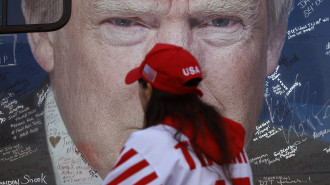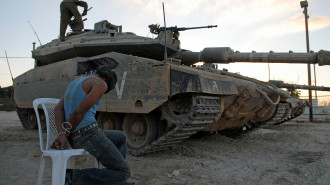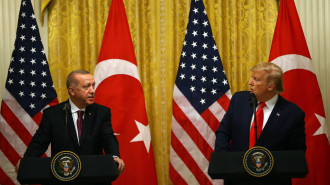How the Egyptian army primed soldiers to kill protesters
During the violent events thousands were killed, burned and lynched.
I was a conscript in the Egyptian army during the breakup of the sit-in at Rabaa Square and served with a military unit near the protest site.
My unit did not take part in the dispersal of the sit-in, but I saw how the officers and soldiers were being primed to attack protesters and opponents of Abdel-Fattah al-Sisi's coup.
Below are some of my observations in brief:
If you don't kill them they will kill you
This was the general rule that the army imparted on the soldiers: claiming that the protesters wanted to kill all members of the military and police.
To drive the point home, the example of their slain comrades in Sinai was used, even though the perpetrators in that case were Ansar Bayt al-Maqdis.
The army blamed those attacks on the Muslim Brotherhood, taking advantage of a statement made by Muslim Brotherhood leader Mohamed Beltagy, in which he said what is happening in Sinai would stop the moment the army reverses the coup and restores former President Morsi to his post.
No leave for soldiers
Anyone who has served in the Egyptian army knows what leave means to the ordinary soldier, and what they will do not to be denied it, including giving up their dignity and fully submitting to any military orders.
At the time of the dispersal of the sit-in, the army suspended leave for most soldiers, who were told something to the effect of as long as the sit-in remains in place, they would continue to be called on to serve in their units or on the streets.
Religious justification of killing
| The Muslim Brotherhood are the heretics of our age, and when we kill them, God, His angels and His Prophet are on our side. |
The exploitation of religion was key to legitimising killing the protesters. Officers and soldiers were made to believe that they were serving their faith and homeland by killing protesters.
The army worked with Sheikh Ali Gomaa, former Grand Mufti and religious adviser to then-Defence Minister Sisi, and other clerics.
I attended a meeting between Gomaa and officers and soldiers. He told us clearly: "When we kill one protester, we are saving one hundred from among the people, because this person would have killed them."
He also said: "The Muslim Brotherhood are the heretics of our age, and when we kill them, God, His angels and His Prophet are on our side."
The unit commanders would also use mosques inside army barracks in Ramadan during the sit-in to further prime and incite soldiers against the protesters.
Exploiting the death of an officer in Al-Bahr Al-Aazam Street
Before the dispersal of the sit-in, Morsi's supporters staged a protest in Al-Bahr Al-Aazam Street. An officer in plainclothes had attacked and run over protesters with his car, killing and injuring several people.
As he tried to escape, protesters captured him, and after verifying he was an army officer, killed him.
I heard about this incident from one of the people who took part in that protest.
The incident was a gift for the army, who used it to convince its officers and soldiers that the Muslim Brotherhood and the protesters were killing any member of the armed forces merely based on this affiliation.
They told the troops that the officer was walking near the protest, and was captured, killed and mutilated for merely being from the army, without mentioning what he did.
They warned us not to get close to any gathering of the protesters. A memo was circulated in the Central Zone (Greater Cairo) warning soldiers and officers against wearing uniforms on any errand or during their leave.
Declaring the Muslim Brotherhood a terrorist group before officially designation
The Egyptian government did not designate the Muslim Brotherhood as a terrorist group until 25 December 2013. This happened after the bombing of the Dakahlia security directorate, which Ansar Bayt al-Maqdis had claimed responsibility for.
However, the army had already designated the Muslim Brotherhood as a terrorist entity in its official correspondence with its units, at least since early August 2013.
The correspondence coming from the defence ministry called on commanders to educate their soldiers about the alleged terrorist nature of the group, and the seriousness of the attacks it was supposedly carrying out in Sinai.
They were even told to say Rabaa Square had weapons, explosives and suicide bombers preparing to attack nearby military installations.
Claiming there were Palestinian militants at the sit-in
| One fax even claimed there were 20,000 jihadists who escaped from Gaza preparing to attack government targets. |
Faxes sent by the then-chief of staff Sedki Sobhi to the defence ministry called on unit commanders to warn officers and soldiers there were Palestinian and foreign militants and suicide bombers embedded with the Muslim Brotherhood protesters.
The faxes also claimed there were weapons that had been smuggled in from Gaza through the tunnels, and would be used to kill army and police officers.
One fax even claimed there 20,000 jihadists who had escaped from Gaza preparing to carry out attacks against government targets.
Infiltration of the sit-in
Military intelligence had infiltrated the ranks of the sit-in with undercover officers, specifically from Unit 75.
They were given national identity cards showing that they were civilian professionals. Some grew beards to blend in.
The informants would tell officers and soldiers that they had seen protestors with weapons and explosives. They claimed the protesters were killing officers and soldiers found near the protest site.
They even alleged Muslim Brotherhood leaders had apartments near Rabaa Square where they were engaging in "sexual jihad."
This article is an edited translation from our Arabic edition







 Follow the Middle East's top stories in English at The New Arab on Google News
Follow the Middle East's top stories in English at The New Arab on Google News


